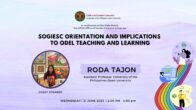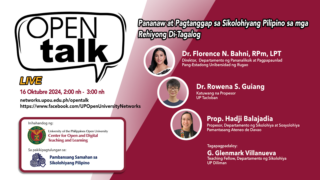Sex, Sexuality, Gender Relations
Prof. Mary Barby P. Badayos-Jover
Terms such as sex, gender or sexuality have been thrown around frequently in current societies. When filling out forms required by your school and other offices, for example, what information is usually asked apart from your name and date of birth? As with anyone else, you are most likely asked to indicate whether you are male or female. Some forms ask for your sex while others require you to write your gender. These concepts are related but not exactly the same. Let us try to understand the meanings behind such terms, as well as the processes and interrelated issues generated by these concepts. Let us start with sex.
Sex refers to the biological characteristics of women and men that includes primary sex characteristics like chromosomes, gonads, [and] genitals. It is considered constant across time as well as constant across different societies or cultures.
Gender Relations or Gender on the other hand refers to the differentiated roles, behaviors, capacities, and intellectual, emotional and social characteristics attributed by a given culture to women and men. It is socially-determined and culturally-defined. It changes across time and cultures. In short, [gender is] all the other differences besides the strictly biological. According to the feminist scholar Judith Butler, the notion of gender is that of performance. It is “a learned performance imposed by normative heterosexual societies.” Meanwhile, the American Psychological Association says that behavior that is compatible with cultural expectations is referred to as gender-normative; whereas behaviors that are viewed as incompatible with these expectations constitute gender non-conformity.
Well, we just mentioned terms like heterosexual societies and gender non-conformity. Let us define human sexuality. Sexuality can be defined as people’s interest in or attraction to others, as well as their capacity to have erotic experiences and responses. It covers a broad spectrum and can be considered deeply personal. Some experts also push forward the idea that human sexuality covers the totality of a person’s physical, emotional and even spiritual responses, including thoughts and feelings. Sexuality encompasses a person’s sexual orientation, gender identity and gender expression.
In recent years, one of the widely accepted graphic illustrations that explains sexual orientation, gender identity and expression is the gingerbread person made by “It’s Pronounced Metrosexual”.
Sexual orientation refers to the inherent or immutable enduring emotional, romantic or sexual attraction to other people.
Gender identity is a person’s innermost concept of self as male, female, a blend of both or neither—how individuals perceive themselves and what they call themselves. One’s gender identity can be the same or different from their sex assigned at birth.
Meanwhile, gender expression is the external appearance of one’s gender identity. It is usually expressed through behavior, clothing, haircut or voice, and which may or may not conform to socially defined behaviors and characteristics typically associated with being either masculine or feminine.
One of the concepts associated with SOGIE or Sexual Orientation, Gender Identity and Expression is that of a transgender. It is an umbrella term for people whose gender identity or expression is different from the cultural expectations based on the sex they were assigned at birth. Being transgender does not imply any specific sexual orientation. Therefore, transgender people may identify as straight, gay, lesbian or bisexual.
There is also such a thing called gender transition, which is a process by which some people strive to be more closely align their internal knowledge of gender and its outward appearance. Some people socially transition, whereby they might begin dressing, using names and pronouns or be socially recognized as another gender. Others undergo physical transitions in which they modify their bodies through medical intervention.
However, there is also what we call gender dysphoria, which is a clinically significant distress caused when a person’s assigned birth gender is not the same as the one with which they identify. According to the American Psychiatric Association’s Diagnostic and Statistical Manual of Mental Disorders or DSM, the term—which replaces Gender Identity Disorder— “is intended to better characterize the experiences of affected children, adolescents, and adults.”
Although we present seemingly “neat” definitions of the concepts of sex and gender earlier, you should note that not everyone, and most certainly not scholars of gender and sexuality, agree that sex and gender can be separated theoretically. According to Clarke and colleagues, sex is often viewed as primary and gender as the cultural “icing” on the biological “cake” of sex, but a close analysis of sex and gender reveals that the sexed body is heavily gendered. The debates about theoretical definitions of sex and gender are beyond the scope of this topic. For purposes of simplicity however, we shall adapt the distinction between sex and gender that we presented earlier.
Now, let’s try and understand how is it that people generally conform to societal expectations related to gender and even sexuality? The answer lies in the process called gender socialization or the socialization of persons into a given gender. This is also called gendering.
There are four processes usually involved in gendering. One is manipulation, wherein people tend to handle boys and girls differently even as infants. Another is a process called canalization, which is directing children’s attention to gender-appropriate objects. The common of which are the toys that we give to children. We have separate toys that we give to girls and separate toys that we give to boys. More often than not, the toys that we give to girls are those associated with expected task that they are going to perform later in life such as child-rearing and housekeeping. On the other hand, the toys that we give to the boys are those that are usually associated with careers.
There is also the process of verbal appellation. Verbal appellation is telling children what they are and what expectations other people have of them. The most classic verbal appellation example is that “boys don’t cry”.
Finally, there is also a process of activity exposure or familiarizing children with gender-appropriate tasks. For example, we tend to teach girls to help in house work, while we teach boys to help in tasks done outside the home. We also tend to expose girls to extracurricular activities such as ballet, while boys are exposed more to sports.
Gendering is only possible with the aid of certain institutions such as the family where we are taught to behave in particular ways. There is also formal education where we can see differences in terms of disciplining boys and girls: in terms of the subjects offered such as elective or practical arts, in terms of images in text books and visual aids, and even in the framing of exam questions and answers.
Another usual institution that [provides] gendering is media or mass media. Mass media consistently portrays women as housewives, emotionally dependent martyrs, victims or scheming villainesses. Advertising uses images to convey or reinforce gender stereotypes. Advertising also often uses sexualized images to sell male-oriented products.
Gendering processes ensure the practice of gender roles—“The social and behavioral norms which are widely considered to be socially appropriate for individuals of a specific sex, within a particular culture.”
According to the European Institute for Gender Equality, collectively, gender roles often determine the traditional responsibilities and tasks assigned to women, men, girls and boys. Gender-specific roles are often conditioned by household structure, access to resources, specific impacts of the global economy, occurrence of conflict or disaster, and other locally relevant factors such as ecological conditions. Like gender itself, gender roles can evolve over time, in particular through the empowerment of women and transformation of masculinities.
The performance or carrying out of gender roles usually result to what we call gender division of labor. This pertains to the allocation of differential tasks, roles, responsibilities and activities to women and men according to what is considered socially and culturally appropriate.
First, we would like to discuss what we call reproductive or care work. These are child-bearing or rearing tasks or domestic tasks done usually by women. These are also referred to as a care and maintenance task of the workforce and the future workforce.
Then we have what we call productive work. Productive work on the other hand is work that is done by both women and men for pay in cash or in kind. This includes both market production with an exchange value and subsistence and home production with actual use value or potential for exchange value. For women in agricultural production, this includes work as independent farmers, peasant wives and wage workers.
Finally, there is what we call community work. Community work is actually divided into two types. One is what we call community management types of work which are activities undertaken primarily by women at the community level. This is considered to be extensions of their reproductive tasks inside the home. These activities are made to ensure the provision and maintenance of scarce resources, such as collective consumption of water, health care and education. Community management work is usually voluntary and unpaid work, and undertaken in what is considered to be free time.
On the other hand, there is what we call community politics, and these are activities or tasks in the community undertaken primarily by men at the community level, organizing at the formal political level and often within the framework of national politics. This is usually paid work, either directly or indirectly, through status or power.
Now, division of labor or gender division of labor results to what we call the phenomenon of multiple burden, which is the condition in which women perform several tasks and responsibilities despite their limited time and energy. This refers to doing unpaid work in the home, paid work as a member of the workforce, and volunteer work in the community.
The phenomenon of multiple burden is directly influenced by the multiple roles that women play. They have the reproductive work done inside the household, productive work in the workplaces, and community management tasks. On the other hand, men are only expected to do productive work and community politics. Multiple burden, as a phenomenon, is actually part of what we call manifestations of gender bias which women are generally the ones suffering from in society.

























This is a very informative and interesting topic that we should know more about. Thank you for sharing.
clear and very informative explain lots and also is true the last part that women are generally the ones suffering from in society.
You’re right ma’am.That’s why our legislators give women more protections through laws.
Informative and comprehensive discussion.
I have so much learnings with this topic. Very informative. Thank you.
Thank you for the knowledge. Very informative and very detailed.